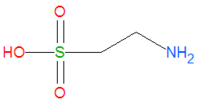Taurine: Difference between revisions
Jump to navigation
Jump to search

imported>David E. Volk m (New page: {{subpages}} {{Image|Taurine.png|right|200px|'''Taurine'''.}} '''Taurine''' is a natural biochemical produced by many, but not all, animals. It is often referred to as an amino acid...) |
imported>David E. Volk No edit summary |
||
| Line 2: | Line 2: | ||
{{Image|Taurine.png|right|200px|'''Taurine'''.}} | {{Image|Taurine.png|right|200px|'''Taurine'''.}} | ||
'''Taurine''' is a natural biochemical produced by many, but not all, animals. It is often referred to as an [[amino acid]] despite the fact that it does not contain a [[carboxylic acid]] group like most amino acids do. It plays an important role in the phase II detoxification of the liver by forming water soluble salts which can be excreted. | '''Taurine''', or '''2-aminoethanesulfonic acid''', is a natural biochemical produced by many, but not all, animals, and is a major constituent of [[bile]]. It is often referred to as an [[amino acid]] despite the fact that it does not contain a [[carboxylic acid]] group like most amino acids do. It plays an important role in the phase II detoxification of the liver by forming water soluble salts which can be excreted. Chemically, it is one of the few naturally occuring [[sulfonic acid]]s and it a derivative of [[cysteine]], another amino acid important in liver detoxification. | ||
Revision as of 20:43, 5 October 2009
Taurine, or 2-aminoethanesulfonic acid, is a natural biochemical produced by many, but not all, animals, and is a major constituent of bile. It is often referred to as an amino acid despite the fact that it does not contain a carboxylic acid group like most amino acids do. It plays an important role in the phase II detoxification of the liver by forming water soluble salts which can be excreted. Chemically, it is one of the few naturally occuring sulfonic acids and it a derivative of cysteine, another amino acid important in liver detoxification.
